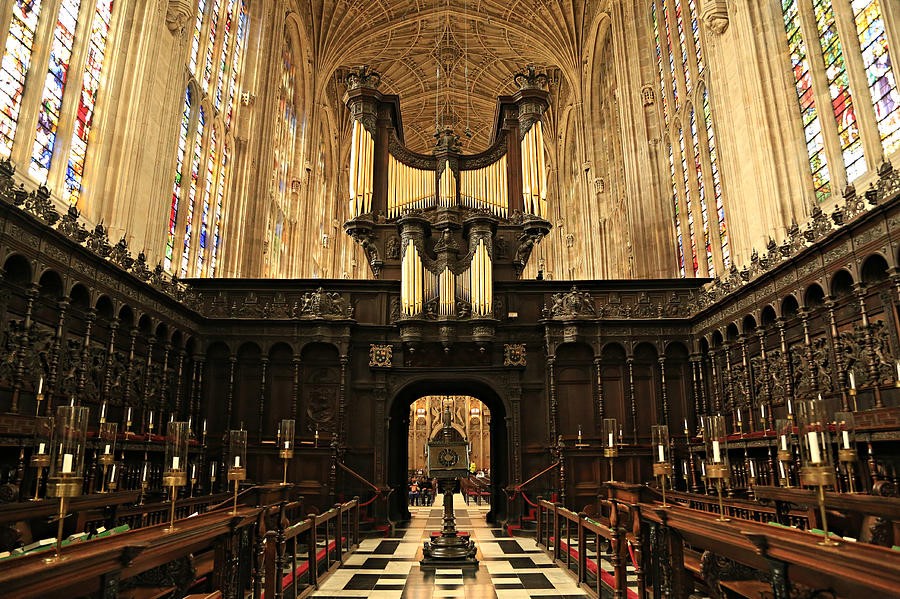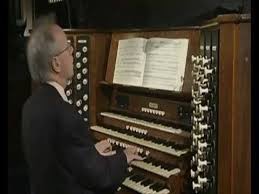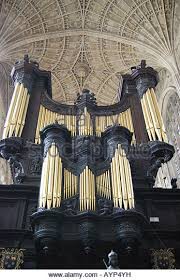The Organs of King’s College Cambridge
 On 4th October 2016 the American Organist Nathan Laube gave the opening recital of the newly restored organ in the famous chapel of King’s College Cambridge.
On 4th October 2016 the American Organist Nathan Laube gave the opening recital of the newly restored organ in the famous chapel of King’s College Cambridge.
 This was the first comprehensive restoration for over 80 years although minor repairs and modifications have been carried out as necessary during the intervening years. The organ was taken out of use in January 2016 and the pipes removed to Harrison & Harrison’s Durham factory for cleaning and repair. In the following months the case, wind systems and actions were repaired and replaced as required with the pipes being re-instated in April to June and voicing and tonal regulation undertaken in August. The organ is now substantially as it was when rebuilt by Harrison and Harrison in 1934 but with modern playing aids and enhanced levels of memory. Cleaning and essential work on the action and blowers has led to a much brighter sound and a markedly more reliable instrument.
This was the first comprehensive restoration for over 80 years although minor repairs and modifications have been carried out as necessary during the intervening years. The organ was taken out of use in January 2016 and the pipes removed to Harrison & Harrison’s Durham factory for cleaning and repair. In the following months the case, wind systems and actions were repaired and replaced as required with the pipes being re-instated in April to June and voicing and tonal regulation undertaken in August. The organ is now substantially as it was when rebuilt by Harrison and Harrison in 1934 but with modern playing aids and enhanced levels of memory. Cleaning and essential work on the action and blowers has led to a much brighter sound and a markedly more reliable instrument.
Early Organs
 It is thought that there were two organs in King’s College Chapel as early as the 1530s. Records show that two small organs were moved from a temporary Chapel used during the construction of today’s Chapel. At least one of these organs was then removed in 1570 at the orders of the Commissioners of Queen Elizabeth and the pipes were sold by Roger Goad (Provost, 1570-1610).
It is thought that there were two organs in King’s College Chapel as early as the 1530s. Records show that two small organs were moved from a temporary Chapel used during the construction of today’s Chapel. At least one of these organs was then removed in 1570 at the orders of the Commissioners of Queen Elizabeth and the pipes were sold by Roger Goad (Provost, 1570-1610).
On 22 June 1605, the renowned organ builder Thomas Dallam began work on a new organ in the Chapel. The accounts for his work have survived, showing in detail the materials and hospitality provided by the College while the work was done. The order for this new organ, totalling £370, was considered so important that Dallam closed his London factory and took his men to Cambridge, where they worked for fourteen months. It is believed that around 25 years later this organ was moved from the East End of the Chapel and mounted on top of the screen.
Although Cromwell’s Long Parliament ordered the removal of the pipes half a century later, the wooden case was left intact, mounted on what is one of the finest Renaissance screens in the country. Successive re-buildings were undertaken by Lancelot Pease (1661), Thomas Thamar (1673-7), Renatus Harris (1686-8), John Avery (1802-4), and the firm of William Hill (1834, 1859, 1889 and 1911).
In 1934 the organ was enlarged and rebuilt in its present form by Harrison & Harrison, with some of the Hill pipework retained and re-voiced. The specification, drawn up in consultation with Boris Ord (Organist 1929-57), included separate mutations on the Choir Organ, unusual in England at that time.
The Case
 There is some uncertainty about the history of the wooden case, which is one of the oldest in England. While it has traditionally been thought that the main case survives from the original Dallam organ of 1605-6, it is more likely that only some decorative components may originate from that time. Its current form is more likely to be a contemporary of the Choir case, which dates from 1661. The front pipes were originally coloured and patterned; the plain gilding dates from the eighteenth century. In 1859 the main case was increased in depth to accommodate the enlarged organ, the console being moved from between the main and Choir cases to its present position on the north side. Today, the Great and Swell Organs and the Tuba occupy the main case, facing east; the Choir Organ is at the lower level behind the Choir case; the Solo Organ and most of the Pedal stops are placed within the screen on the south side.
There is some uncertainty about the history of the wooden case, which is one of the oldest in England. While it has traditionally been thought that the main case survives from the original Dallam organ of 1605-6, it is more likely that only some decorative components may originate from that time. Its current form is more likely to be a contemporary of the Choir case, which dates from 1661. The front pipes were originally coloured and patterned; the plain gilding dates from the eighteenth century. In 1859 the main case was increased in depth to accommodate the enlarged organ, the console being moved from between the main and Choir cases to its present position on the north side. Today, the Great and Swell Organs and the Tuba occupy the main case, facing east; the Choir Organ is at the lower level behind the Choir case; the Solo Organ and most of the Pedal stops are placed within the screen on the south side.
The organ will be heard again in all its glory as BBC TV and Radio broadcast the annual Festival of Nine Lessons and Carols on Christmas Eve this year.
Specification
| PEDAL ORGAN | CHOIR ORGAN (enclosed) | GREAT ORGAN | SWELL ORGAN (enclosed) | SOLO ORGAN |
| 1. Double Open Wood (from 2) 32 | 23. Double Salicional 16 | 39. Double Open Diapason 16 | 54. Quintatön | 69. Contra Viola 16 |
| 2. Open Wood 16 | 24. Open Diapason 8 | 40. Open Diapason I 8 | 55. Open Diapason | 70. Viole d’Orchestre 8 |
| 3. Open Diapason (from 39) 16 | 25. Claribel Flute 8 | 41. Open Diapason II 8 | 56. Violin Diapason | 71. Viole Octaviante 4 |
| 4. Geigen 16 | 26. Salicional 8 | 42. Stopped Diapason 8 | 57. V oix Céleste | 72. Cornet de Violes lll |
| 5. Bourdon 16 | 27. Dulciana 8 | 43. Octave 4 | 58. Lieblich Gedeckt | 73. Harmonic Flute 8 |
| 6. Salicional 16 | 28. Gemshorn 4 | 44. Principal 4 | 59. Echo Saliciona | 74. Concert Flute 4 |
| 7. Echo Violone (from 69) 16 | 29. Suabe Flute 4 | 45. Wald Flute 4 | 54. Quintatön | 75. Cor Anglais 16 |
| 8. Violoncello (from 4) 8 | 30. Nazard 22/3 | 46. Octave Quint 22/3 | 55. Open Diapason | 76. Clarinet 8 |
| 9. Flute (from 5) 8 | 31. Dulcet 2 | 47. Super Octave 2 | 56. Violin Diapason | 77. Orchestral Hautboy 8 |
| 10. Fifteenth (from 13) 4 | 32. Tierce 13/5 | 48. Open Flute 2 | 57. V oix Céleste | 78. French Horn 8 |
| 11. Rohr Flute 4 | 33. Larigot 11/3 | 49. Mixture 19.22.26.29 IV | 58. Lieblich Gedeckt | 79. Tuba 8 |
| 12. Open Flute 2 | 34. Twenty-second 1 | 50. Sesquialtera 17.19.22 III | 59. Echo Salicional | |
| 13. Mixture 12.15.17.19.22 V | 35. Corno di Bassetto 8 | 51.* Contra Tromba | 60. Vox Angelica 8 | |
| 14. Double Ophicleide (from 15) 32 | 36. Contra Tromba 16 | 52.* Tromba | 61. Principal 4 | |
| 15. Ophicleide 16 | 37. Tromba 8 | 53.* Octave Tromba | 62. Lieblich Flute 4 | |
| 16. Trombone (from 51) 16 | 38. Octave Tromba 4 | 63. Fifteenth 2 | ||
| 17. Double Trumpet (from 66) 16 | 64. Mixture lll | |||
| 18. Cor Anglais (from 75) 16 | 65. Oboe 8 | |||
| 19. Posaune (from 15) 8 | 66. Double Trumpet 16 | |||
| 20. Tromba (from 51) 8 | 67. Trumpet 8 | |||
| 21. Octave Tromba (from 51) 4 | 68. Clarion 4 | |||
| 22. Schalmei 4 |
David Wakefield
| I was the President of the Organ Club of Great Britain from 2009 to 2012 and I am a Vice president of the Eric Thompson Trust, which provides bursaries for specific educational projects for young professional organists; and I chair the Larkin Trust with similar aims but associated with St. Giles Cripplegate and the Royal College of Organists, of which I became a Trustee and Council Member in 2013. I was elected to the committee of SSLSO at the 2016 AGM.
My interest in all things “organ” has gone from being an occasional hobby to something of an unpaid profession, through which I have developed a range of contacts and informants. I will try and find relevant items from the world of organs, organists and organ music to entertain and inform you each month. |

